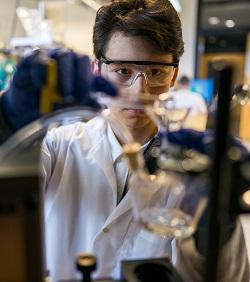Methane conversion, the process of converting methane to desirable products such as methanol or syngas, has garnered the title as the holy grail of catalysis. As the primary component of natural gas, the complex chemistry of methane has limited its potential for sustainable utilization, perplexing researchers for over a century with countless methods and experimental approaches attempted to develop an economically viable process for chemical production. Like finding the holy grail (although without the mythos and eternal life), the rewards of finding a solution to this challenging process could potentially turn methane into a viable alternative fuel. My research, funded by a Summer Undergraduate Research Fellowship (SURF), uses a photocatalytic approach (accelerating a chemical reaction by using light) for selective methane conversion to methanol and syngas through oxidation by hydrogen peroxide.

In my lab group, I focus on methane conversion and collaborate with my mentor, lab mates, and research colleagues, who have different research topics but share similar experimental approaches. As a group, we help each other by reviewing literature, troubleshooting instrumentation issues, and practicing our scientific communication skills together. This collaboration is crucial and helps hone our understanding of catalysis. Before communicating my results, however, I work through three laboratory phases for one set of results: photocatalyst synthesis, activity testing, and data analysis.
Synthesis is the procedure to form the photocatalyst. Minor configurations of its surface interface, including defects in the crystal lattice, decoration with metallic nanoparticles (such as gold, platinum, palladium, or rhodium), and alteration in band structure may all affect how the photocatalyst interacts with methane, but may be controlled by the choice of technique. I frequently use the deposition-precipitation technique, where I stir different chemicals in solution to anchor onto each other, allow the desired photocatalyst to precipitate, remove any remaining water from the precipitate through drying, and calcine the material at high temperatures to alter its atomic structure.
Next, activity testing determines how successful the newly synthesized photocatalyst facilitates methane conversion. In my case, I prepare a photoreactor that flows methane and an inert gas at steady state through an aqueous solution containing the photocatalyst and the oxidant: hydrogen peroxide. Once the reactor is loaded, I turn on a light source that shines high intensity ultraviolet (UV) light through the solution, causing methane and hydrogen peroxide to decompose into radical species that may favor an oxidation reaction to form methanol and syngas.
Finally, I analyze the results from activity testing to determine how much methane reacted and what products were produced. If there are favorable results, the photocatalyst is subsequently characterized to determine the properties it possessed to favor methane conversion. These steps are multi-instrumental and apply many different techniques including imaging, spectroscopy, and surface chemistry to understand the photocatalyst’s mystifying properties and see its atomic interface.
My daily laboratory work is comprehensive, but exhilarating. Working in-lab has added depth to my experience that is hard to attain remotely. Hands-on learning has provided me essential laboratory skills for my career and has put me right into the middle of the action. While there are certainly long hours, they pass by quickly by being proactive about other parts of the project, such as literature review, analysis, and more. I always like to think of the research process as an adventure. Devising a new method that successfully solves complex research topics is like pioneering into the unknown, where groundbreaking progress must be made, obstacles overcome, and pathways charted for others to follow. It is quite the unexpected journey.
